
The ferns are a group of vascular plants that reproduce via spores and have neither seeds nor flowers. They differ from mosses by being vascular, i.e., having specialized tissues that conduct water and nutrients and in having life cycles in which the branched sporophyte is the dominant phase.

Equisetum is the only living genus in Equisetaceae, a family of vascular plants that reproduce by spores rather than seeds.

Cirsium palustre, the marsh thistle or European swamp thistle, is a herbaceous biennial flowering plant in the family Asteraceae.
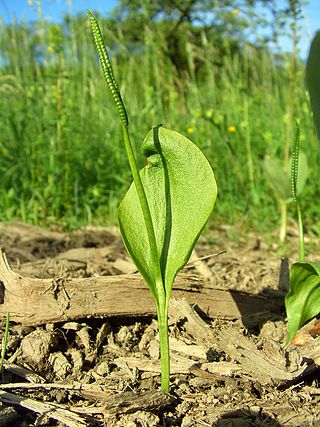
Ophioglossum vulgatum, commonly known as adder's-tongue, southern adder's-tongue or adder's-tongue fern, is a species of fern in the family Ophioglossaceae.

Mentha aquatica is a perennial flowering plant in the mint family Lamiaceae. It grows in moist places and is native to much of Europe, northwest Africa and southwest Asia.

Equisetum fluviatile, the water horsetail or swamp horsetail, is a vascular plant. It is a perennial herbaceous pteridophyte.

Equisetidae is one of the four subclasses of Polypodiopsida (ferns), a group of vascular plants with a fossil record going back to the Devonian. They are commonly known as horsetails. They typically grow in wet areas, with whorls of needle-like branches radiating at regular intervals from a single vertical stem.
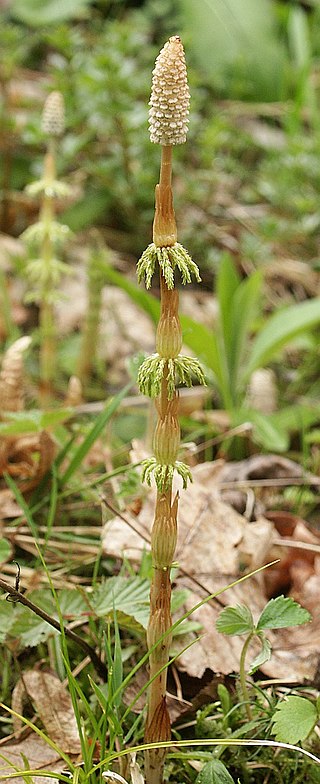
Equisetum sylvaticum, the wood horsetail, is a horsetail native to the Northern Hemisphere, occurring in North America and Eurasia. Because of its lacy appearance, it is considered among the most attractive of the horsetails.
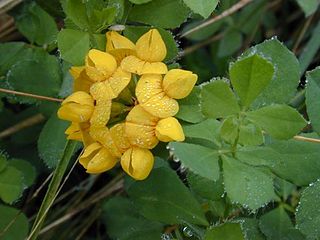
Lotus pedunculatus, the big trefoil, greater bird's-foot-trefoil or marsh bird's-foot trefoil, is a member of the pea family (Fabaceae).

Equisetum arvense, the field horsetail or common horsetail, is an herbaceous perennial plant in the Equisetidae (horsetails) sub-class, native throughout the arctic and temperate regions of the Northern Hemisphere. It has separate sterile non-reproductive and fertile spore-bearing stems growing from a perennial underground rhizomatous stem system. The fertile stems are produced in early spring and are non-photosynthetic, while the green sterile stems start to grow after the fertile stems have wilted and persist through the summer until the first autumn frosts. It is sometimes confused with mare's tail, Hippuris vulgaris.
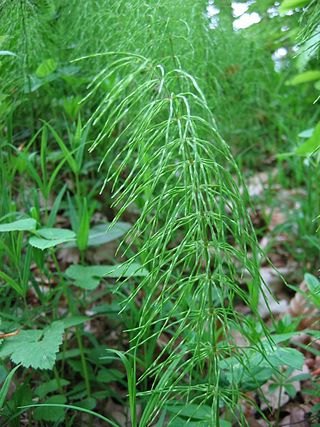
Equisetum pratense, commonly known as meadow horsetail, shade horsetail or shady horsetail, is a widespread horsetail (Equisetophyta) and it is a pteridophyte. Shade horsetail can be commonly found in forests with tall trees or very thick foliage that can provide shade and tends to grow closer and thicker around streams, ponds and rivers. The specific epithet pratense is Latin, meaning pasture or meadow dwelling.

Equisetum telmateia, the great horsetail or northern giant horsetail, is a species of Equisetum (puzzlegrass) with an unusual distribution, with one subspecies native to Europe, western Asia and northwest Africa, and a second subspecies native to western North America. The North American subspecies is often simply but ambiguously called "giant horsetail", but that name may just as well refer to the Latin American Equisetum giganteum and Equisetum myriochaetum.
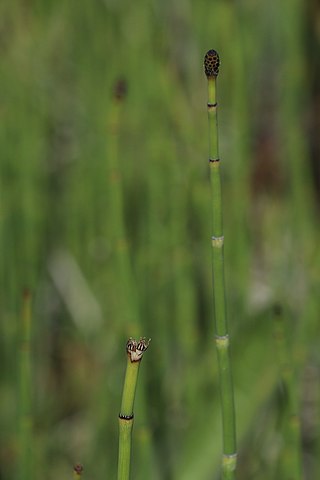
Equisetum laevigatum is a species of horsetail in the family Equisetaceae. It is known by the common names smooth horsetail and smooth scouring rush. This plant is native to much of North America except for northern Canada and southern Mexico. It is usually found in moist areas in sandy and gravelly substrates. It may be annual or perennial. It grows narrow green stems sometimes reaching heights exceeding 1.5 meters. The leaves at the nodes are small, scale-like brownish sheaths and there are occasionally small, spindly branches. The stems are topped with rounded cone-shaped sporangia.

Equisetum hyemale is an evergreen perennial herbaceous pteridophyte in the horsetail family Equisetaceae. It is a native plant throughout the Holarctic Kingdom, found in North America, Europe, and northern Asia.

Diphasiastrum complanatum, common names groundcedar, creeping jenny, or northern running-pine, is a species of clubmoss native to dry coniferous forests in colder northerly parts of the world. Under the original name Lycopodium complanatum, this was an inclusive superspecies that included a number of other species now known to be biologically separate. This plant is an evergreen, perennial pteridophyte. The spores are produced June to September.

Spinulum annotinum, synonym Lycopodium annotinum, known as interrupted club-moss, or stiff clubmoss, is a species of clubmoss native to forests of the colder parts of North America, as well as Asia, and most of Europe. It is an evergreen perennial pteridophyte. The genus Spinulum is accepted in the Pteridophyte Phylogeny Group classification of 2016, but not in other classifications, which submerge the genus in Lycopodium.

Rorippa palustris, marsh yellow-cress, bog yellow-cress or common yellow-cress, is a species of flowering plant in the family Brassicaceae. It is widespread and native to parts of Africa, and much of Asia, Europe and Eurasia, North America and the Caribbean. It can also be found in other parts of the world as an introduced species and a common weed, for example, in Australia and South America. It is an adaptable plant which grows in many types of damp, wet, and aquatic habitat. It may be an annual, biennial, or perennial plant, and is variable in appearance as well.

Equisetum scirpoides Michx., Fl. Bor.-Amer. 2: 281 (1803). 2 n = 216.The smallest of the currently occurring representatives of the genus Equisetum (horsetail).
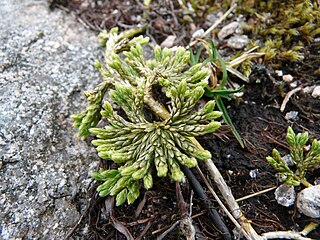
Diphasiastrum alpinum, the alpine clubmoss, is a species of clubmoss. This plant is a glaucous scale-leaved perennial pteridophyte. In Finland, the spores are produced June to September. It was first described by Carl Linnaeus in his Flora Lapponica, 1737, from specimens obtained in Finland.
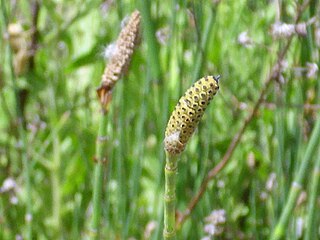
Equisetum ramosissimumDesf., known as branched horsetail, is a species of evergreen horsetail.




















